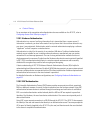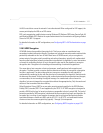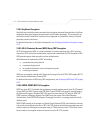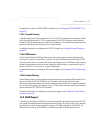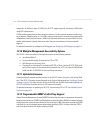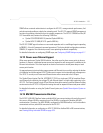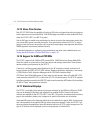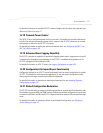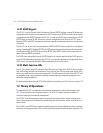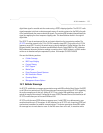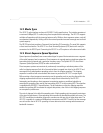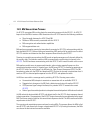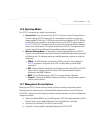
AP-5131 Access Point Product Reference Guide
1-16
1.2.15 Voice Prioritization
Each AP-5131 WLAN has the capability of having its QoS policy configured to prioritize the network
traffic requirements for associated MUs. A WLAN QoS page is available for each enabled WLAN on
either the AP-5131 802.11a or 802.11b/g radio.
Use the QoS page to enable voice prioritization for devices to receive the transmission priority they
may not normally receive over other data traffic. Voice prioritization allows the AP-5131 to assign
priority to voice traffic over data traffic, and (if necessary) assign legacy voice supported devices (non
WMM supported voice devices) additional priority.
For detailed information on configuring voice prioritization over other voice enabled devices, see
Setting the WLAN Quality of Service (QoS) Policy on page 5-34.
1.2.16 Support for CAM and PSP MUs
The AP-5131 supports both CAM and PSP powered MUs. CAM (Continuously Aware Mode) MUs
leave their radios on continuously to hear every beacon and message transmitted. These systems
operate without any adjustments by the AP-5131.
A beacon is a uniframe system packet broadcast by the AP to keep the network synchronized. A
beacon includes the ESSID, AP-5131 MAC address, Broadcast destination addresses, a time stamp,
a DTIM (Delivery Traffic Indication Message) and the TIM (Traffic Indication Map).
PSP (Power Save Polling) MUs power off their radios for short periods. When a Symbol MU in PSP
mode associates with an AP-5131, it notifies the AP-5131 of its activity status. The AP-5131 responds
by buffering packets received for the MU. PSP mode is used to extend an MU’s battery life by enabling
the MU to “sleep” during periods of inactivity.
1.2.17 Statistical Displays
The AP-5131 can display robust transmit and receive statistics for the WAN and LAN ports. WLAN
stats can be displayed collectively and individually for enabled WLANs. Transmit and receive
statistics are available for the AP-5131’s 802.11a and 802.11b/g radios. An advanced radio statistics
page is also available to display retry histograms for specific data packet retry information.
Associated MU stats can be displayed collectively and individually for specific MUs. An echo (ping)
test is also available to ping specific MUs to assess association strength. Finally, the AP-5131 can
detect and display the properties of other APs detected within the AP-5131’s radio coverage area. The
type of AP detected can be displayed as well as the properties of individual APs.





